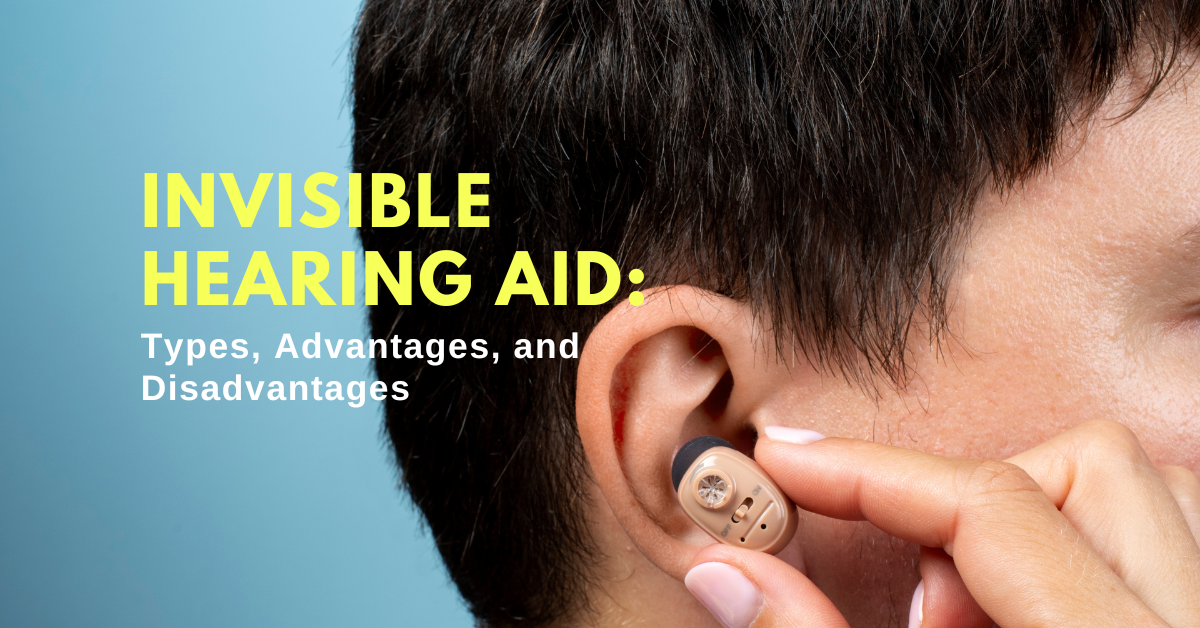An invisible hearing aid refers to a hearing aid style that sits inside the ear canal of an individual with hearing impairment. These devices have gained high popularity due to their discreteness and almost invisibility when worn. Surprisingly, despite being small, these digital hearing aids are integrated with the most advanced technologies that improve the hearing experience to a great level.
In the following blog, we will discuss the difference between invisible and traditional heaving devices, the types of invisible hearing devices, who should wear them, and a lot more. So let’s get started.
How does an Invisible Hearing Aid differ from a Traditional Hearing Aid?
Some parameters on which invisible hearing devices differ from traditional ones include:
- Visibility: Invisible hearing devices fit deep in the ear canal. On the other hand, traditional ones sit behind or around the ear.
- Custom Fit: Invisible hearing devices are custom-made for a precise fit, while traditional ones come in standard sizes.
- Sound quality: The deeper placement of invisible hearing devices may slightly affect sound compared to traditional aids.
- Battery and Maintenance: Compared to traditional ones, invisible hearing devices are smaller in size. Hence, they may have shorter battery life and require more delicate maintenance.
- Suitability: Invisible hearing devices work best for mild to moderate hearing loss. On the other hand, traditional aids support varying degrees of hearing loss.
How does an Invisible Digital Hearing Aid Work?
An invisible hearing aid requires five major components to function. One can find these components in a tiny plastic shell that fits inside the ear canal comfortably. Below we have mentioned these components along with their role:
- Microphone: The microphone collects sound from the external environment, transforms them into electrical signals, and forwards them to the amplifier.
- Amplifier: An amplifier boosts the sound waves and forwards them to the DSP for further processing.
- Digital Signal Processor (DSP): The DSP processes the sound waves to improve sound and speech clarity.
- Receiver/Speaker: The receiver delivers the processed sound to the ear.
- Battery: A battery keeps the device working.
Who can use an Invisible Digital Hearing Aid?
Individuals with mild to moderate hearing loss can use these devices. However, many invisible digital hearing aids address severe hearing loss as well.
What are the Different Types of Invisible Hearing Devices?
Invisible hearing aids come in different types. Each of these types offers different features.
- Invisible in the canal (IIC): Invisible in the canal hearing aids fit deep inside the ear canal. Therefore, they cannot be located from the outside and offer a discreet style to the user. These devices adapt to the external sound environment automatically and work great for minimizing wind noise.
- Completely in the canal (CIC): Completely in the canal hearing aids fit entirely inside the ear canal. Therefore, they are nearly invisible to outsiders. Due to their custom-design options, they fit any ear and canal shape. Moreover, they come with manual controls that individuals can use to adapt to different external sound environments.
- In the canal (ITC): In the canal hearing aids sit partly in the ear canal. However, a small part of these devices can hang from the ear. Despite being small, these devices can be custom-made to fit different ear canal shapes. Furthermore, ITC devices have directional microphones that amplify important sounds and minimize irrelevant noise.
- Miniature receiver in the ear (miniRITE): miniRITE fits easily and comfortably in the ear canal. These invisible hearing aids fit every type of hearing loss. Furthermore, these devices can be connected to smart devices via Bluetooth. They also offer rechargeable battery options.
What are the Advantages of an Invisible Hearing Device?
Invisible hearing devices offer numerous advantages if used as per the directions of a trusted audiologist or hearing aid clinic. The prime benefits of these devices include:
- Comes in small sizes and camouflaging colors that look discreet in the ear.
- Do not have external tubes and wires for more discretion.
- Eliminates wind and other external noise that may affect hearing.
- Leaves room for inserting external objects like earbuds or stethoscopes in the ear.
- Provides more natural sound for a better hearing experience.
- Offers custom-fitting options to provide users with more comfort.
What are the Disadvantages of an Invisible Hearing Device?
On the other hand, these devices also have a set of challenges. Some of the disadvantages of using these devices include:
- Come with smaller controls that can be hard to see/feel.
- Do not support binaural coordination for two devices.
- Have a shorter battery life.
- May not suit all ear canal shapes.
- Not all models may support Bluetooth connectivity.
- Individuals with dexterity may need help handling these devices.
How much does an Invisible Hearing Aid Cost?
The cost of an invisible hearing device depends on the following factors.
- Integrated technology
- Inclusive audiology services and warranties
- Geographical location
However, you can consult a hearing aid clinic to get an estimated cost of your preferred invisible hearing device.
What to check before Selecting an Invisible Hearing Aid?
Before selecting an invisible digital hearing aid we recommend consulting a trusted audiologist or hearing aid clinic. During the consultation, check if your preferred device meets the following parameters:
- Check if the hearing aid fits you.
- Analyze which device model and color look discreet in your ear.
- Ensure the technology integrated with the device improves your hearing experience.
- Examine which type of battery the device supports – disposable or rechargeable.
- Note if the preferred device meets your budget.
Conclusion
In conclusion, an invisible hearing aid can be a great solution for individuals facing hearing loss yet who don’t want others to know about it. Yet we suggest consulting a trustworthy audiologist or hearing aid clinic to select the most suitable option for an enhanced hearing experience.

